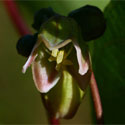|
Manihot (Cassava genus) Life
> eukaryotes >
Archaeoplastida >
Chloroplastida
>
Charophyta > Streptophytina > Plantae (land plants)
> Tracheophyta (vascular plants) > Euphyllophyta > Lignophyta (woody plants)
> Spermatophyta (seed plants) > Angiospermae (flowering
plants) > Eudicotyledons > Core Eudicots > Rosids >
Eurosid I > Order: Malpighiales > Family: Euphorbiaceae
About 100
species, native to America. Cassava Manihot
esculenta and three other species are cultivated in tropical areas of southern Africa and
often occur as escapees. An additional species is cultivated in the
region.
Species naturalised in southern Africa
List from
Plants
of Southern Africa - an Online Checklist (SANBI).
Manihot dichotoma
Native to Brazil. |
|
Manihot esculenta (Cassava, Manioc)
Native to west-central Brazil and domesticated about 10 000 years ago.
Cultivated in southern Africa and has also become naturalised in the region. Tapioca is manufactured from the starchy tuber. It can
also be used to produce an alcoholic drink and to make flour. The leaves can be
eaten as a vegetable. Cassava is the third greatest source of carbohydrates for
humans in the world, with the greatest production in tropical Africa. |
 |
Manihot glaziovii (Ceara rubber)
Native to Brazil. |
|
Manihot grahamii (Guazu
mandioca, Mandioca brava)
Native from Brazil to Argentina. |
|
Other species, cultivated in southern Africa
List from Glen (2002).
Manihot leptopoda (Maniva,
Mandioca brava)
Native to Brazil. |
|
Publications
|
